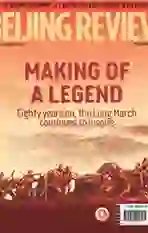THE LONG MARCH GOES WEST
2016-05-14ByLiangXiao
By Liang Xiao
‘Edgar Snow put a human face to the Communist Party of China (CPC) and introduced the CPC leadership to international and domestic audiences. For Snow, his book Red Star Over China was a way to stress the common bond between China and America at the time,” said John James Kennedy, a professor at the University of Kansas, during a recent seminar in Beijing.
The four-day seminar was held to commemorate the 80th anniversary of the end of the Red Armys Long March and also the 80th anniversary of Snows interview with Mao Zedong.
“His mission was to bring the United States and China closer together and [create] greater mutual understanding,”Kennedy said.
Started in 1982, the biennial seminar is hosted alternately in Beijing and Snows hometown, Kansas, Missouri. It aims to recall the life and achievements of the American journalist and strengthen people-to-people exchanges between China and the United States.
Snow is regarded as one of the most important foreigners to present China to the world. He first came to China in 1928, staying on for 13 years. In 1936, the then 31-year-old visited the CPCs revolutionary base area in northwest China, interviewed top communist leaders including Mao and Zhou Enlai, and amassed a treasure trove of first-hand information. He published his seminal book in the following year, presenting his eye-opening accounts to Western readers.
The second session of the seminar, held in Peking University on October 12, was attended by Chinese and American dignitaries. They included Li Yansong, Vice President of Peking University and Director of China Center for Edgar Snow Studies; Nancy Hills, President of Edgar Snow Memorial Foundation; and Yuan Xiling, a researcher in the Edgar Snow Research Center in Shaanxi Province.
In his keynote speech, Bao Shixiu, a senior research fellow with the Academy of Military Sciences, said during Snows four-month visit to the revolutionary base area, he found that though life was hard and supplies ran short, civilians, officers and soldiers remained united. In the Red Army soldiers enthusiasm for the revolution and the local support for these revolutionaries, he saw Chinas hope. He introduced this zeal and dedication and the people who lived by them to the world through his articles, helping the West understand China better.
Bao said the reason China is observing the 80th anniversary of the end of the Long March so solemnly and spontaneously nationwide is the heroism of the Red Army. It has fired the dreams of the Chinese and made China move forward. Snow, he said, held the Long March in very high regard. According to Dr. John K. Fairbank, a prominent American academic and historian of China, who wrote the introduction to a new edition of Red Star Over China, in 1936, no Western observer had had direct contact with the CPC leadership or reported on its struggles and progress to the outside world. As the first Western journalist who reported the real spirit of Chinese communists and the legendary Long March, his book has stood the test of time as a historical record. Sun Hua, Deputy Director of China Center for Edgar Snow Studies, told Beijing Review that Snow was trusted by Western readers because he presented his narrative with facts. When he wrote about the CPC and the Red Army, he used first-hand materials. His record of Maos life especially, from the birth of the Chinese leader to the victory of the Long March, is very real and accurate.
